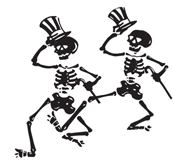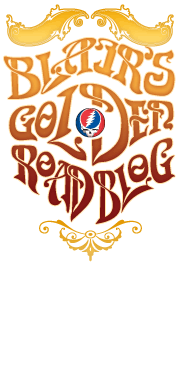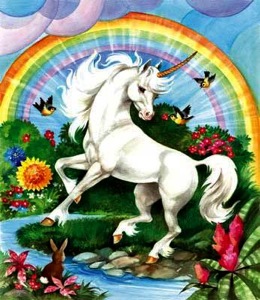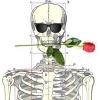We live in a cynical age. Believe it or not, “rainbows and unicorns” is a term that is used pejoratively online to describe that segment of Grateful Dead fans (and those of the post-Garcia bands) who believe that the Dead were, in a sense, beyond criticism. These folks believe that what the Dead did musically, coupled with the experience of being at shows with other Dead Heads was (is) so profoundly positive that it seems somehow unfair to complain about it in any way. They would really prefer you not say a negative word, thank you.
I was that guy for many years. From the time I first saw the band in the spring of 1970, through about 1981, I really didn’t have anything bad to say. Were there songs I didn’t like and times I was a little bored? Absolutely! But I can’t recall ever coming away from a Dead show during that period feeling disappointed. I just loved everything about the band and the scene. Going to Dead shows was Magic Time for me. “Rainbows and unicorns” isn’t exactly an apt description of what my Grateful Dead worldview was — I was more “lightning and dragons” — but I felt a kinship with the utopian idealists who believed that the Dead environment could be a paradigm for a New Age, even with the hustlers and hucksters and burnouts and shady types who were always part of the scene.
And that never changed for me. I never took the Grateful Dead experience for granted. It always remained Magic Time for me — even when the shows became something less than consistently magical the last couple of years. What changed, though, is that sometime in the early ’80s I encountered — and soon became —“ANOTHER PICKY DEADHEAD” (as a bumper sticker of the time said).
Two things happened in the early ’80s that fostered the rise of the PDH: 1) More and more people went on tour, seeing multiple shows in different cities, along the way becoming more critical about song selection, repeated tunes and such; and 2) Tape collecting exploded, so suddenly fans were making more direct comparisons between, say, the 1980 Dead, and the 1977 or ’69 Dead. Hit four or five or six shows on an ’81 or ’82 tour, and chances are you’d get a few “Lost Sailor-Saints,” “Alabama Getaways” and either “Black Peter,” “Wharf Rat” or “Stella” in the late second set ballad slot. What’s wrong with that? Nothing, of course! The band still mixed up their sets more than any other band on the road (in fact no group was even close in those days), and the fact is, look at almost any earlier era of Dead music — when very few folks toured — and you’d find much more similarity in the song selection from night to night. In ’77, they played “Estimated” at 51 out of 60 shows. In ’71, they played “Casey Jones” and “Sugar Magnolia” almost every night. I didn’t hear anyone complaining about “Row Jimmy” turning up at 61 out of 72 shows in 1973. But by the mid-’80s a significant number of Dead Heads had become jaded.
In my own case, starting my Dead ’zine The Golden Road is what really pushed me down the path of PDH-dom. Before ’84, I had never cared about what the band was playing night to night on tour, much less attempted analyses of trends in the group’s repertoire. It never occurred to me. I went to shows, I had a great time, I went home a better person! Before 1982, though, I also wasn’t going to between 20 and 30 shows a year, so every concert seemed more special, I suppose. I will say, though, that I never compared whatever version of the Dead I was seeing with earlier incarnations I'd enjoyed. I definitely accepted that they were what they were in that present day, not some pale comparison with the Dead of '72 or '77. Because fundamentally, it still hit me the same way.
However, by the mid-'80s for me, it became a game of anticipation: “They opened with ‘Scarlet’ two nights ago, so we probably won’t hear that. We’re about due for another ‘Throwing Stones’ > ‘Not Fade Away’ closer, but I’d rather hear ‘Sugar Mag.’ I can’t believe Bob chose ‘Looks Like Rain’ instead of ‘Playing.’” It wasn’t pretty, people. I’m not proud of thinking those thoughts. (And admit it, some of you had those notions, too.) Still, very rare was the show that didn’t get me off, no matter what was played. If I had a moment’s thought of “Gee, ‘Throwing Stones’ again?” it never prevented me from enjoying a well-played version to the fullest. We all have our favorites, but if there’s passion in the effort, I can enjoy pretty much any song, and that continues to be true for me.
The last several years of going to shows definitely tested my generally positive outlook. There were a few “new” songs I thought were actually bad (no names here), and then there was the whole matter of Jerry’s decline, which had to have been apparent even to the extreme “rainbows and unicorns” types. There were shows that left me … disturbed. And yet, to the bitter end I was upbeat about the next tour and the renaissance I was sure was coming around the bend. I guess I couldn’t see the dark clouds through my own rainbow glasses.
Since Jerry’s death, I have moved back toward the “rainbows and unicorns” camp when it comes to the post-GD groups. In the process, I’ve been subjected to the slings of arrows of the new breed of PDH—hyper-critical Internet critics for whom nothing short of an appearance by Mr. Garcia himself could quell the relentless and at times disturbingly personal sniping at the surviving band members and their efforts. The level of vitriol in their commentary is shocking. The Internet is a take-no-prisoners war zone.
But I feel that Phil, Bob, Mickey and Bill have admirably dedicated themselves to thoroughly exploring the Grateful Dead’s incredible repertoire and taking the Dead approach to playing in many new and unexpected directions with an amazing variety of players. At the same time, they’ve made a conscious attempt to keep the Dead Head community spirit alive, for veterans like me and for the young ’uns coming up. And that’s why I’m no longer jaded. Just grateful.




